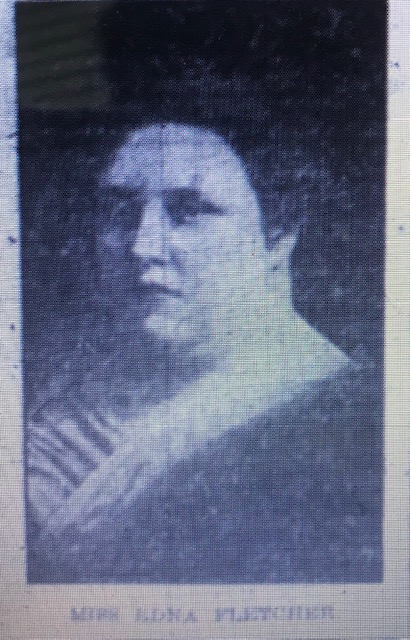
By early December 1918, more than 360,000 Americans have died since early September. That’s more than 100,000 every month, every thirty days, as of December 4, 1918, the 90th day since influenza broke out of Fort Devens, Massachusetts.
Thankfully, as of now on the 90th day, though the sickness has not completely stopped, it has certainly declined. The lowering scale of death is noticeable.
But what does it mean and what has it meant?
One woman makes an effort to offer an answer, at least for her. It was, in essence, a dying decision.
Edna Fletcher, the night-shift supervisor and nursing-student director at Methodist Hospital in Indianapolis, Indiana, first got influenza five days ago, the day after Thanksgiving. The irony was that she had survived the deadliest October in American history in one of the deadliest places in the Midwest for influenza, Fort Benjamin Harrison. She had done hero’s work in leading a dozen young student-nurses—volunteers, all—to the fort to care for soldiers and staff suffering from influenza. Two of her volunteers were among the dead, victims of the illness.
They called her Maw, a nickname made from Fletcher’s constant habit of watching over everyone and, frankly, nagging about the smallest details of nursing. Edna Fletcher was exacting and demanding, didn’t suffer fools or the lazy or the indifferent gladly, and refused to bend or compromise on what she saw as the standards of excellence for the nursing side of healthcare. As the longest-serving employee of the hospital and outfitted with an eternal vision of caring for patients, Maw was formidable, unforgettable, and a force that affected every nurse who knew her.
Edna Fletcher knew influenza, the signs of contracting the illness, and the various markers toward either recovery or death. By the third day, she knew the outlook was bleak. By the fourth day, her day of death, she had decided. Her decision had implications for the meaning of the pandemic.
The cemetery.
Her final question was where to be buried, something a 33-year old doesn’t expect to ask. Fletcher’s choices were what you’d think—she could be buried in Indianapolis where she worked and was well-regarded as a female leader in healthcare; she could be buried where she had grown up, in a small, southern Indiana town called Ellettsville known for its limestone; or maybe, if the right people in the right positions said yes, she could even be buried at Fort Harrison where she had served the last chapter of her professional and purposeful life.
None of these were acceptable to her.
Fifty-five years before Fletcher’s choice, Abraham Lincoln had once delivered a short speech at a cemetery. In the span of a few minutes on Cemetery Hill in Gettysburg, Pennsylvania, Lincoln had read from a paper to a crowd, using phrases like “these honored dead” and “last full measure of devotion.” The keynote speaker at Cemetery Hill, Edward Everett, later told Lincoln he had captured and shared more meaning in a few minutes than Everett had done in nearly a two-hour speech.
No one asked Edna Fletcher to give a speech. No one asked her to reflect on the larger message of this horrible autumn. Even if they had, she was too weak, too close to death, to do so. But she could express a final and lasting thought in where she would be buried.
Take my body to the place where my calling and my purpose first began, where they first found life. As a nurse. As a teacher of nursing. As a leader who can forge the bonds and blaze the pathways between other people finding what they are meant to do and learning the knowledge for going somewhere to do it.
My way of death will not matter. My moment of death will not last. Influenza may have killed my body but it cannot stop my spirit of living, a spirit seen in the work and the people who came to me to learn the work. And I cared for people in their fight against the sickness. We waged our war together. So my spirit will never perish.
Lincoln’s words took a few minutes. Fletcher’s words took no form at all apart from the long, black vehicle leaving the funeral home, casket secured in the back. Going northwest out of Indianapolis, the driver follows one of the oldest transportation routes in Indiana, a path known as the Lafayette Road.
* * * * * * * * * * * * * * * * * * * * * * * * * * * * * * * * * * * *
At the Spring Valley cemetery in Lafayette, Indiana the work was nearly done. The gravediggers were almost finished with digging up the freezing dirt. So was the stonecutter, chiseling the name “Fletcher” in rock. Limestone, of course.
The day leaves early on a December’s late afternoon. Light weakens and retreats behind windows and to the top of lamp posts. Chill turns to cold. Birds and animals quiet down to look for shelter and slow down to search for warmth. Things fade to an end. Here, the waters of the Wabash River flow into the night of a declining autumn.
Not far from Spring Valley cemetery sits the State Soldiers Home. The Home has a nurses’ training school. Soft lights glow in the windows.
Five years ago, the school’s director, a person with total control, was Miss Edna Fletcher. She was one of the first such leaders in the state of Indiana. She wanted to be buried where, for her, life found a meaning, the meaning birthed a purpose, and the two together made a devotion, fully shown to a last measure, that would hallow this ground.
The cemetery is dark. The burial is tomorrow.
And the 90th day fades away.
A thought for you on Day 90, June 8, 2020, ninety days after President Trump declares Covid-19 a national emergency—the wave ahead—this entry launches a new phase in my “Today In 1918” series. Fletcher’s story is an appropriate spot at which a pause begins. I will commence daily entries again at the time when the next wave of influenza returned in 1919. I’ll mark my return to reflect the actual time-lapse between the waves of 1918 and 1919. As was true in the 1918 pandemic, I believe another wave is ahead for us in 2020, one which corresponds to the next wave of the 1918-1919 pandemic. Also, crawling further out on the limb of predictions, I tend to think that the next wave will be less lethal medically but much more difficult and problematic socially, culturally, politically, and so on. For us, Warfluenza will reach a worse stage in the next wave. I’d love to be wrong. We’ll see. I hope you’ve found the series helpful thus far. I will maintain the style and spirit of the first portion of my series when I return for the next wave some time from now in “Today In 1918-1919.” Until then, be well.

(note to reader—I invite you to subscribe to this series/blog. The purpose of my posting in this series is the purpose of my enterprise at Historical Solutions—to explore the past in a new way that brings new and different value to you, both in the present (this minute) and on the edge of the future (what’s ahead or forward of this minute). The past is everything before now, the totality of all time before the present; history is a set of very small slices of the past that, for a particular reason, have been remembered. If you wish to contact me privately, please do not hesitate to text or call 317-407-3687)







